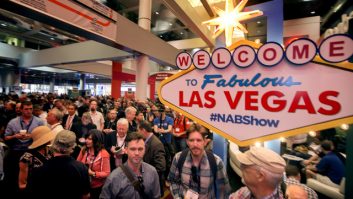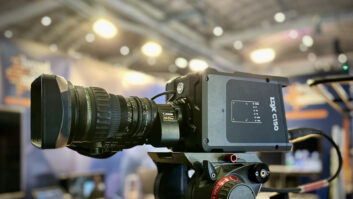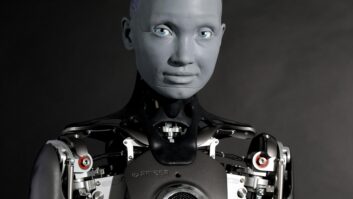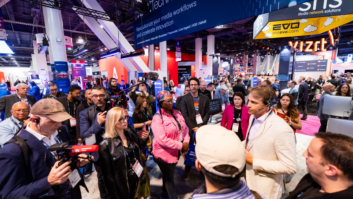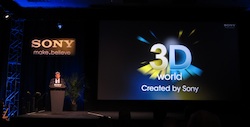
Commoditisation or specialist perfection? Dick Hobbs presents his round-up of events in Las Vegas, but begins several thousand miles away at the Thames Valley Group meeting of the Royal Television Society. Containing a mix of manufacturers, systems integrators, consultants and broadcasters, the audience meet to talk about what they saw (or what they missed) and what they identified as the pulse of the event
This year’s RTS meeting saw a heated argument around a fundamental issue for the future of the industry: how far we are moving towards commoditisation, and is this a good thing? What happens to specialist suppliers if you can buy all the equipment you need from petty cash?
The NAB Store itself was selling an ‘HD’ camera for $299. True, it might be unlikely to pass too many codes of practice. But Blackmagic Design’s stunning announcement that the da Vinci Resolve colour corrector – which you would traditionally expect to cost well into six figures – will shortly be available in a software-only Mac version for $995 is a game-changer.
Or take the Wirecast live production tool from Telestream. This gives you camera switching, graphics, DVE and encoding, all in software, for that same $995. And from Sony there is a new a palm-sized HD camcorder. Again, it is not a top end device, recording 24Mbps AVC and no XLRs or PCM audio. But that apart it is very attractive at Euro 1400 – which includes two years’ support from Sony’s broadcast operation.
Quantel – whose strapline at NAB this year was ‘Let’s talk business’ – was proud of a major financial turnaround, getting back into comfortable profitability. And what did the company identify as a key driver for this transformation: seamless integration of Final Cut Pro. Two big contracts in 2010 alone have been worth $10 million to Quantel, because their products can now interface with what is, we should remember, fundamentally a consumer, mass-market product.
Quantel was not the only company quietly proud that it survived the crisis and is moving ever upward. I profiled Pebble Beach Systems in this magazine recently, and its CEO told me that in the ten year history of the business they had never needed to borrow money.
Its success continues, most recently with the contract to provide a four-channel automation and asset management system to Satellite Telecommunications Network in Slovenia. At the other extreme, it has also won a contract from GloboSat in Brazil, in which the first phase alone automates 48 channels.
And Ross Video, still family-owned with a Ross as CEO, claimed 18 continuous years of growth, giving it the security to continue to innovate. This year, for instance, it expanded its Vision range of production switchers to include the Octane which, as its name hints, can support up to 8 M/E banks. Which sounds like a lot, but if you are producing multiple feeds – the various screens around a sports stadium, for example – it might be really useful.
Workflow automation
One of the more popular ways of filling in time waiting for the Icelandic ash to clear was visiting an Apple Store and trying out the iPad (yes, I did bring one home). Some manufacturers at the show were ahead of us, of course: Autodesk had a neat sketchpad tool that linked into its professional visualisation systems, and Multidyne was showing an iPad app to control its fibre transport systems.
Recognising, though, that the main use for the iPad will be to consume media, so Anystream updated its Agility streaming system to provide full support. That includes segmented HTTP live streaming for instant playback on adaptive bitrate feeds.
It also announced the launch of Avalon, a metadata packaging system. We are faced with the unavoidable situation that all of the content delivery platforms, and sometimes the devices within those platforms, have different requirements not just for the content but for the metadata.
Indeed, it was suggested to me that getting the metadata format right is harder than the video, and incorrect metadata is one of the biggest reasons for rejection by the iTunes store. This seems like a useful solution to a problem which has until now been largely solved manually.
Getting the best possible quality out of the content, though, is still extremely important, and this has been a Telestream specialisation for ten years now. FlipFactory is almost a byword for high performance transcoding, but it is being increasingly pushed into workflow automation, so this year it has added Vantage, a product specifically developed to speed the design and build of workflows.
You simply plug together the functionality you require, which will certainly include FlipFactory but also other tools like routing and analysis. This allows the system to make intelligent decisions around trade-offs between quality and file size, for example. A simple graphical user interface is claimed to make it simple for those who are not programmers to create new workflows.
Before leaving Telestream, can I offer a personal recommendation for its Episode software. It has the simple aim of very good quality encoding, quickly, giving you more than 100 different output formats for an amazing $495. With the Pro version you get more functionality and the ability to create processing farms from networks of Macs and PCs. It is a simple solution to a real problem.
Digital Rapids was also focussing on delivering top quality in a flexible workflow. Like Anystream, it took the opportunity to showcase adaptive steaming, demonstrating live and on demand content across a huge range of platforms including broadcast television, game consoles, netbooks, mobile television and the iPhone.
Harris had an iPhone app on its booth, to allow citizen journalists to shoot video and send it to a designated cache server. The app attaches metadata to the video, including a GPS reference so you know when and where it was shot – always the first question when checking authenticity – and a call-back number for the sender. The metadata becomes searchable in a Harris Invenio asset management system.
Perhaps the most interesting comments from Harris, though, concerned digital signage, which it sees as a major market. Sports arena installations alone could, the company believes, be worth as much as $1 billion a year in the near future. In retail, it has just set up a service for McDonalds, covering 5000 restaurants with four channels played out from Harris headquarters in Florida, but allowing local content insertion. This looks very much like an interactive television playout operation, and is clearly the way forward for digital signage.
Another company offering a link for the iPhone for news was Streambox. Its free download allows the iPhone to broadcast near live – latency is up to five seconds. While that would make interviews impossible, for some content it would be perfectly acceptable: a Detroit broadcaster mounted them on snowploughs as a quick and easy way of showing the state of the roads. The same software can run in a 3G wireless equipped Apple MacBook Pro, where bonding two channels together gives enough bandwidth for broadcast quality standard definition, or HD which is acceptable in an emergency.
Publishing policy
Maybe I have been writing NAB reviews for too long, but I can remember – not that far back – feeling the need to define the term metadata. Now the challenge seems to be giving everyone access to it.
That, at least, is the thinking behind the latest developments at TMD. Collecting and managing the metadata is no longer enough: it is only of any sort of value when it can be put to work. So, for example, TMD is extending its applications from straightforward broadcast asset management to national and cultural archives. It is developing a huge cataloguing system with the National Archive of Australia that includes video and audio but also documents and artefacts, all of which are searchable by anyone online.
To manage the huge archives that are now being considered – Discovery Channel’s system was specified to cover 1.4 million tapes, and already TMD is expanding it to 1.6 million – demands automation on the way in and automation on the way out. Software can strip the metadata from an MXF file and use it to populate a database, for example.
Conversely, it should now be a simple matter to define a publishing policy and use that to drive both the transcoding and the metadata transcription for, say, the iTunes store, without any operator intervention.
Front Porch Digital, too, was looking at large-scale archives as a key business focus. For both the European Parliament and the US Library of Congress it has developed systems for the mass migration of videotapes.
Its core product Diva is now developing into a service oriented architecture – I was told that ‘you had to do it these days’ – to provide operationally-driven workflows. Front Porch Digital has also added a new product, Diva Net, to provide synchronisation between remote server installations, for disaster recovery or for load balancing.
With the assumption that content can now be treated as data, everyone needs storage, and SANs were more or less everywhere. Fibrenetix had a very neat solution for editing on the move, for instance: 8TB and a four-port ethernet switch in one box to help news bureaux cover big stories.
Studio Network Solutions pitches its Evo San at post production workgroups, concentrating on performance. It streams uncompressed HD over two parallel gigabit ethernet feeds, for example, taking advantage of the fact that the Mac Pro has two ethernet ports.
Immediately after NAB came the news that Omneon had been taken over by Harmonic. They certainly kept the news very quiet throughout the exhibition, although they were emphasising the number of codecs now supported on Omneon servers, and how they continue to achieve excellent cue to play times.
Also emphasised was the connectivity, with the freedom to add third party storage from the likes of Apple Xsan or Isilon, and the ease of connection for external users such as editors.
From Grass Valley the server news was the latest release of software for its K2 Summit production server. This allows I/O to be grouped together to form logical channels. So an eight I/O K2 Summit could support two super slo-mo cameras, each with three actual inputs (for three times normal framerate recording) and an output being treated as a single virtual channel. Similarly, pairs of inputs could be ganged for stereoscopic 3D, again making it easier to operate because the two eyes are locked together in a single file.
Established as a content delivery service, Signiant has rapidly grown to become an industry standard. At NAB it launched a new peer-to-peer system that allows individual user networks to trust each other. Effects houses might use it to move content to and from a principal post house on a major production, for instance.
On the Signiant booth I was put on the spot, when asked what I guessed the penetration of file-based connectivity currently is. Their estimate is as low as 5-15%, not least because users still see online data transfer as a security risk. The Signiant service includes a digital waybill that guarantees not only that the received file is an exact copy of the original but that it has not gone anywhere else, so has not been pirated.
Frame compatible 3D
It was hard to ignore stereoscopic 3D at NAB this year. A survey of visitors by Hamlet suggested that almost three quarters of visitors had stereoscopic 3D as one of their reasons for being there. For all those who do get involved in it, I hope that, as well as the flashy production and post tools, they also invest in a Hamlet VidScope-3D if they want to be in with a chance of maintaining consistent quality.
Inevitably the 3D attention was drawn by a large number of flashy – and to my eyes far from universally successful – demonstrations. Alongside them, though, there was some rather more sober discussion about how it might be broadcast. In the absence of any other standards at present it seems we are likely to use what has become known as frame compatible mode. This means halving the resolution of each eye in one direction – side by side seems to be the favourite – and putting them together in a single channel.
As we are still fighting the battle to keep HD standards up, halving the horizontal resolution seems very much like a backward step. Coming to the rescue is Sensio Technologies, which has intelligent filtering to “mitigate the loss of resolution”. This requires processing at both ends of the link to get the benefit of the quality.
Miranda added cards with Sensio processing to its modular range, and Grass Valley launched a Sensio-powered transmission encoder in its ViBE family, so the headend takes in the two HD-SDI signals and outputs a transport stream which looks like MPEG HD to the delivery platform.
The same two companies also share solutions to another easily overlooked 3D issue. If you use a mirror rig, one of the cameras has to be flipped to get the picture the right way around. Grass Valley claims that its standard camera architecture means that the output can be reversed or inverted internally with no latency. Miranda offers another modular card that inverts one feed and delays the other to match.
With the Olympics just gone and the World Cup just ahead, there was a lot of talk about sport, and 3D in particular. To get the signal back from the event, Grass Valley also launched a new encoder for 3D contribution, the ViBE VA5004, which uses linked JPEG2000 compression engines to get the best possible quality and matching.
Nevion, too, was placing a great deal of emphasis on JPEG2000, and the challenge of guaranteeing good quality of service across a complex network – such as bringing the football home from South Africa. They have come up with a concept they call Perfect Switch, which they claim will provide path protection, using parallel networks if required, across any platform.
The claim is that, using the Nevion technology, protection switching is completely seamless: I was told that it will not lose a single bit. Despite this, latency is relatively low, because both protected feeds are being buffered.
We are all still waiting for OLED monitors to deliver on their promise, but it seems the manufacturing challenge of growing large screen sizes have yet to be met. Sony was displaying a gorgeous 7.4” OLED monitor with wonderfully rich, dark blacks, excellent colour rendition and a wide uniform viewing angle. A tantalising glimpse of things to come.
Fixing the 19” rack
I started this article by talking about the RTS review of NAB, and one of the issues raised by a panellist, Guy Elliott of EMEA Gateway, was perceived loudness. He made the joke that commercials are louder than programmes so that you can hear them over the sound of the kettle, but in reality we would all prefer it if a consistent level of loudness could be set and maintained.
A number of exhibitors tackled this issue. TSL has a new modular device that detects loudness errors, reports them and at least attempts to fix the problem.
Wohler has a new device that incorporates processing licensed from both Junger Audio and Linear Acoustics, allowing you to choose the sound quality on a job by job basis. NBC used the device to add its commentaries to the effects track at the Winter Olympics in Vancouver.
And before leaving audio I have to mention Snell. The latest addition to its iQ modular range is an analogue audio DA which, to retain that authentic sound quality, actually includes a valve on the board. Younger readers may not have come across a ‘valve’ before, so will not understand the massive hoops that Snell has gone through to get enough power to the card just to make it work. I am sure that there are many audio purists who will appreciate the effort.
Last, but definitely not least, I would like to draw your attention to the sort of product only an engineer could love, but I promise that you need to try it. Mode-Al has challenged the old adage about not trying to fix something that is not broken, and immeasurably improved something we all take completely for granted: the 19” rack.
Specifically, it has looked at the frustration and scraped knuckles every engineer experiences in building racks and come up with a better way of fixing equipment. It does not change the mounting holes of hardware so it is perfectly compatible with everything you already own. And it was demonstrated on the NAB booth with a standard frame from Argosy.
It is impossible to describe in detail how it works without seeing it. But can I strongly recommend you do go and see it: you will wonder why it has taken 70 years for someone to come up with an idea that is so obviously right.
